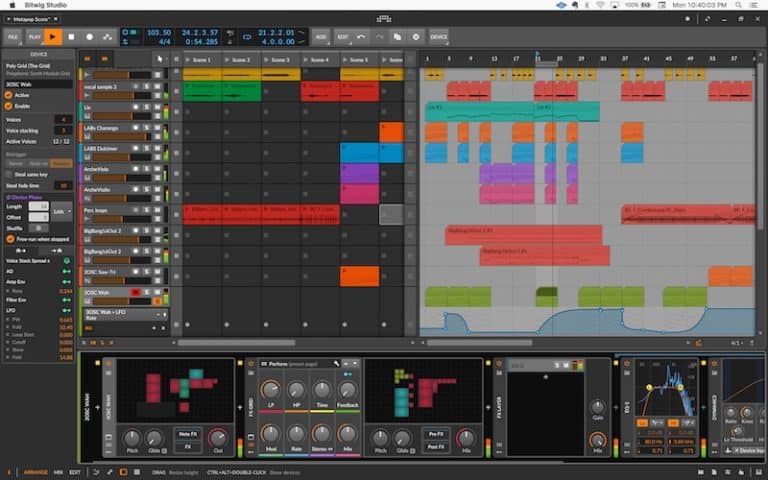

This puts documentation and notes of every instrument, effect, and modulator parameter right in the program. Interactive Help View is coming to all devices: The Interactive Help View is now available for all devices throughout Bitwig Studio.

Slice In Place: The new function Slice In Place allows you to slice selected clips, events and notes either at detected audio Onsets, at inserted Beat Markers, or at a set beat interval. And then go straight to drum editing or whatever else you had in mind. Now on click and drag, lines will appear at every interval of the beat grid, showing where cuts will be made on release.

Just select the knife tool and hold the Alt key. Quick Slice: With Quick Slice, cutting clips, notes, and events is easier as well. Quick Draw locks to one pitch by default (think hi-hats, etc.), but it can also be used freehand to drag each note to any pitch, kind of like inputting notes with a step sequencer.
#Bitwig studio 3 series#
Simply hold the Alt key while using the pen tool to draw a series of notes on the current beat grid (for example, 16th notes, 8th notes, etc.). Quick Draw: With Quick Draw, you can swiftly and effortlessly paint notes in the note editor. Because with a filter frequency or an EQ band, sometimes it is easier to think in pitch. Now when any frequency parameter is hovered over or edited, the equivalent note value (and whether it is in tune, sharp, or flat) is shown right beside the frequency. Window Footer Shows Frequency + Pitch: Since version 3, the window footer has featured a wealth of helpful information. Since every signal is stereo in The Grid, Transpose has three stereo configurations, and while it’s a processor, it can even create chords when no input is provided. It improves a range of tasks, like stacking oscillators into chords, or creating just intonation intervals. Extending pitch control to The Grid is the new and deceptively simple Transpose module. This could trigger a unique effect on “out” notes, or take classic ideas in a new direction (like the Constant Portamento preset, where every note glides from the same root pitch). The new modulator, Pitch-12, provides a modulation signal when any note type is being pressed (C, D, etc.). And beyond Bitwig Studio’s instruments, hardware (via control voltage) and any plug-in instrument that supports MPE or VST3’s note expressions can also be tuned in this fashion. The settings are all imported, and any comments will be inserted as the preset description. In addition, certain Scala (SCL) files can be loaded by dropping them onto a Micro-pitch device. Bitwig’s heart is modulation, and animating the parameters can make a musical phrase ever more dynamic and expressive. And a few presets reshape the keyboard, coaxing new and unexpected outcomes from even an experienced player.īut this only scratches the surface. Some are cultural (from instruments of China or Java), and some were made by artists (like Charles Ives, Harry Partch, and Wendy Carlos) for their own unique works. Some represent historic temperaments, like those of Kirnberger, Werckmeister, and Broadwood, bringing an out-of-time feeling to any passage. Some are theory-based, using overtones, undertones, quarter-tones, or even tuning A4 to 432 Hertz. The initial beta release already includes over thirty presets, showcasing myriad possibilities. By making the world of tuning accessible, a world of sounds can be loaded or crafted. Micro-pitch is a new Note FX device for re-tuning note streams in a variety of ways. Native Instruments explains why it’s stopped selling Absynth.The Model D App is now available in all major DAWs.


 0 kommentar(er)
0 kommentar(er)
